Heading out the door? Read this article on the new Outside+ app available now on iOS devices for members! Download the app.
As I sit and write this, it’s less than a week from the start of the 2024 Tour De France. It’s also less than a week from the moment every brand involved in racing is hoping to stand out with a win. If you feel excited about the whole Tour spectacle,e, just think about how it feels to be a part of it.
After a year of careful planning, now is the time to make it happen. Each new idea is a chance to help an athlete get an edge. We’ll be covering the Tour as it happens, but for now we are planning too. As part of that planning we’ve been thinking about what we might see in terms of new tech.
Here’s a few predictions for the tech we’ll see at this year’s Tour De France. Some of these are wild and crazy, some of them are all but guaranteed. Let us know what you think of these predictions. Are they too wild for reality? Is there anything you expect to see that we are missing?
Sena Race Radio
Before I get wild, I’m going to start this off with something that’s confirmed. As of March of this year, Israel-Premier Tech is partnering with Sena to solve a problem that no one thinks much about. That problem is clear communication.
Right now, race radios aren’t that good. There’s a big radio in the pocket of a rider’s bib short that’s dangerous in a crash. There’s also buttons and cables that once pressed or unplugged a rider can’t fix. On top of it all, the quality is so low that it’s not always clear who’s talking and it’s difficult for coaches in the team car to manage the radio while driving.
Sena is a company that understands vehicle to vehicle communication. The brand offers communication solutions for motorcycles and boats as well as bikes. The Race Radio system will bring that same clarity and ease of use to team communication.
The Race Radio system starts with a team car console that’s reminiscent of an Apple TV box. When it’s time to communicate with a rider all the team car has to do is squeeze a button and start talking. That button can even sit on the steering wheel.
On the athlete’s side, a small nodule sits on the back of the helmet. From there a small wire with a mic connects to the rider’s custom earpiece. The system uses Sena’s Mesh Intercom network and it connects then pairs to the whole team automatically. It’s even compatible with Shimano shifters allowing the button on the top of the hoods to activate the radio.
I’m told that right now this system is only confirmed for time trial stages with Team Dsm–Firmenich PostNL and Israel-Premier Tech. The question remains will we see it make a difference, and will it make the leap to road stages as well? Perhaps this will help keep rider vs team car interactions to a minimum?
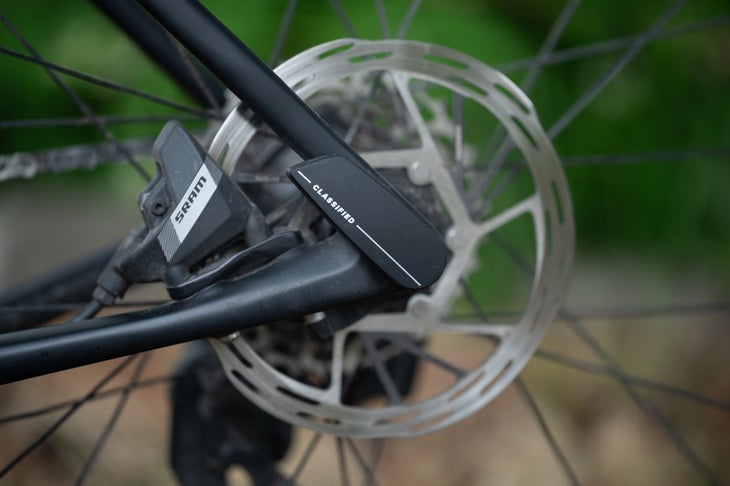
Classified will see use in TT stages and maybe more
Classified Cycling is another tech we expect to see in TT stages. Unlike Sena I haven’t had any direct communication about which team or what stages, but this tech in use shouldn’t be a surprise to anyone. Classified Cycling is a technology that’s been seeing more and more use over the last few years and it’s likely to pop in the 2024 Tour De France as well.
If you aren’t familiar with Classified, it’s essentially a next generation front derailleur. Instead of hanging the shifting mechanism for the front chainring on the seat tube, it’s in the rear hub. Pressing a button somewhere on the handlebar makes the gearing 30 percent easier and it’s both instant and usable under full load. This allows for the best of both worlds when it comes to gearing range and aerodynamics.
You can expect to see Classified rear hubs paired with giant dinner plate aero front chainrings. This is pretty much a guaranteed thing for a TT stage but will we see more? WolfTooth has recently introduced a big aero chainring and is a sponsor for Team Jumbo-Visma. Last year we saw Wout van Aert’s 1x equipped Cervélo S5 sporting SRAM chainrings and a WolfTooth aero chain guide. Maybe this year we see a road bike with Classified and WolfTooth combined?
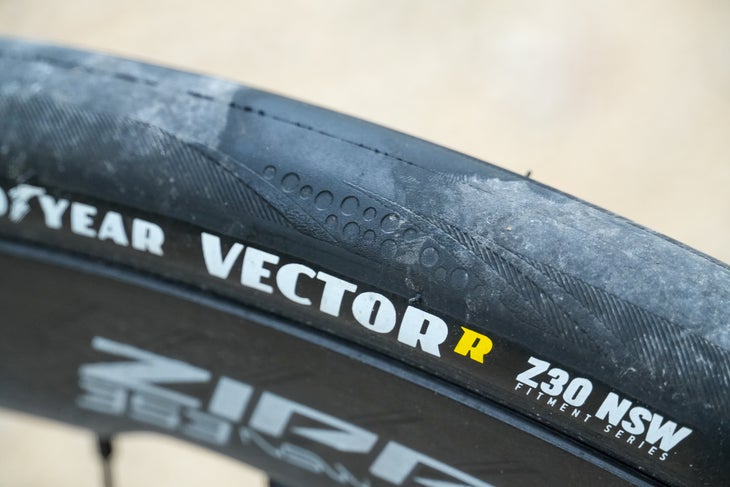
30mm tires
There are some who are predicting that gravel bikes will show up at the 2024 Tour De France. My experience talking to those responsible for decisions like that leads me to predict we will not see that. For most people, gravel bikes make sense but in the Tour I find it unlikely, even if there is a stage with gravel sectors this year. It’s too big of a leap from what decision makers know will work.
Instead of the drastic move to a gravel bike, I expect to see teams make an incremental move to bigger tires. In certain situations there is still an aero benefit to narrow tires but current tech means it’s not as universal as it once was. Deep wheels and narrow tires are still the king of aero when alone. As long as riders aren’t targeting a breakaway though, there are real benefits to going wider.
Shorter wheels paired with wider tires are both comfortable and aero enough for most situations. There are also a number of wide internal hookless wheels in the peloton this year and concerns for safety will probably dictate wider tires to match. We’ve seen the move to 28mm tires, now the time is right for teams to go all the way up to 30mm.
The big question here is going to be how much does it matter? What’s the equation for deciding that wider and more comfortable is enough of a benefit?
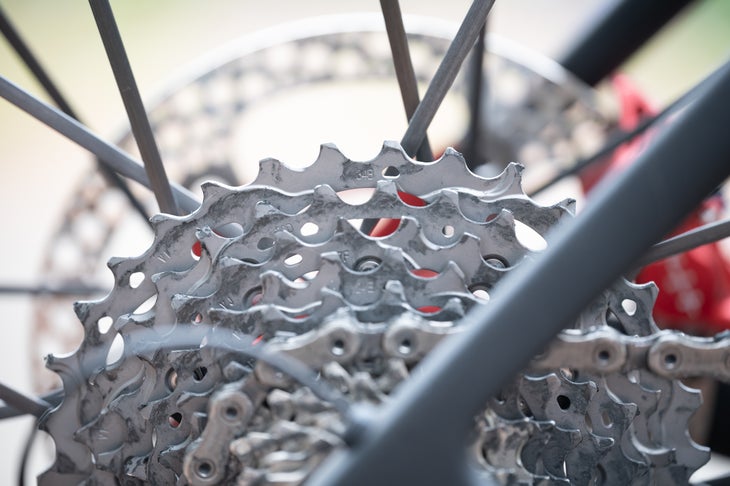
Wide range cassettes
As long as we are talking about the crossover between consumer trends and pro rider trends, it makes sense to discuss cassettes. Just five years ago a 28 or 29 tooth max on a rear cassette was a big deal. Today Shimano offers an 11-34 while SRAM has a 10-33 but bikes made with UCI racing in mind still tend to choose narrow gearing with smaller rear cassettes.
Given that gears are a good thing, I expect we’ll see more wide range cassettes this year. For some that might mean the already mentioned Classified rear hub with its lack of overlapping gear and 30 percent gearing reduction. There is still a weight penalty to Classified, though, plus sponsorship considerations. Most teams who want climbing gears will reach into the SRAM or Shimano catalog, but how big will they go?
It’s also an open question of what chainrings we’ll see paired with those wide cassettes. Will there be 1:1 gearing in use during climbing stages? Or will Pro Tour teams stick to the kind of gearing seen on consumer bikes with UCI credentials?
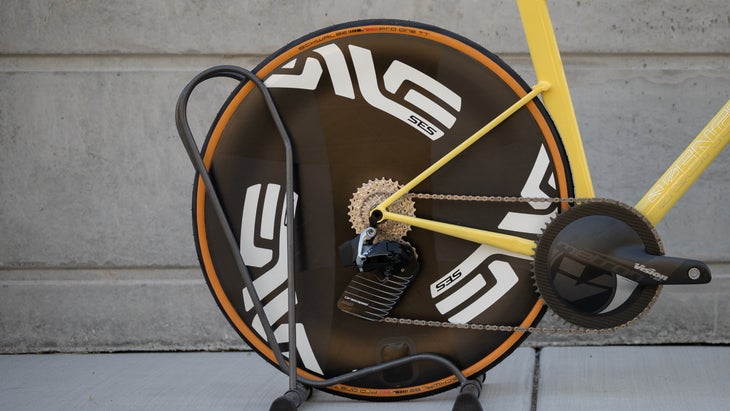
Enve TT bike
Now it’s time to jump to something that’s purely speculative. It seems obvious that Enve is working on a time trial bike. During a recent trip to the Enve factory, there was talk of custom aero extensions specifically designed for Tadej Pogačar and the Tour de France. Although I didn’t see those extensions, I did inadvertently get images of a new Enve SES disc wheel.
That means that right now Enve has an updated time trial wheel and unreleased aero extensions. Enve is also sponsoring Team TotalEnergies with road wheels and the Melee road bike but has no solution for time trial days (they’ve been using blacked-out bikes from previous sponsor Specialized in the meantime). Add all that up and there’s an obvious hole in the lineup.
The only question that remains is if we are going to see a secret new bike at the 2024 Tour De France. Enve has the capability to design and test a frame as well as the necessary components to build out the system. Is there anything holding back the addition of a new frame type?
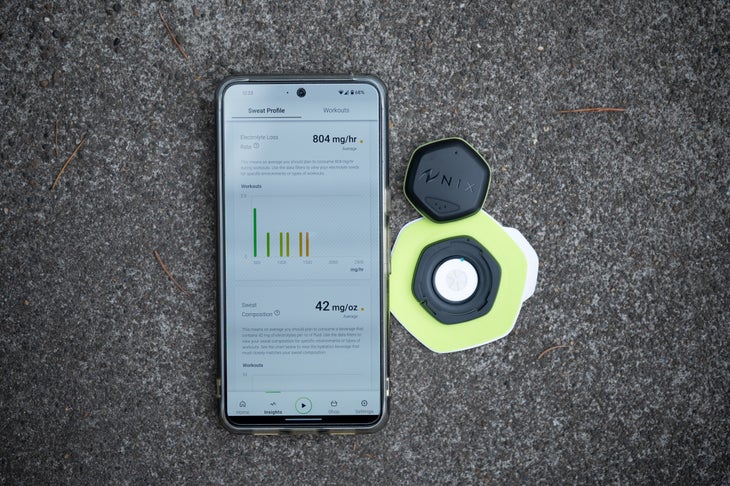
Temperature regulating tech
As I’ve been leading this discussion through mild to wild, I had a hard time deciding where to put this one. Temperature regulating technology has been growing in use over the last few years. Riders with ice vests during warm weather are a common sight these days, but Unbound saw the release of Rapha Blaero Project and something similar from Rule 28 and Castelli. Will that mean anything for the 2024 Tour De France?
I reached out to Rapha to see if a skin suit with an integrated bladder is even UCI legal but I haven’t heard back. There are some older rules that mention Camelbacks, specifically that “It must not be the case that the system, presented as a way of improving a rider’s hydration during an effort, is accompanied by a ‘aerodynamic clothing’ advantage, in this way deflecting the camelback system from its original function.” That might mean it’s totally off the table but if it’s not, adding ice to a skin suit with an integrated bladder could be a huge advantage to teams.
Even if those systems are a no-go, temperature regulating technology is going to be a big deal. It seems likely that we will see use of the Core body temp sensor. Core has made big inroads in the pro peloton but it’s not the only sensor in this space. Nix is a sweat sensor that monitors how much you are sweating in real time. It can help you stay hydrated based on what your body is actually doing in the moment and Nix just released a group hydration solution. The new product allows access to a “full team’s hydration data in a single view.” Among the listed groups who “trust” Nix are EF Pro Cycling and Israel Premier Tech. Will we see high tech solutions added to the relatively low tech ice vests?
2024 Tour de France Tech Predictions - velo.outsideonline.com
Read More
Bagikan Berita Ini

















0 Response to "2024 Tour de France Tech Predictions - velo.outsideonline.com"
Post a Comment